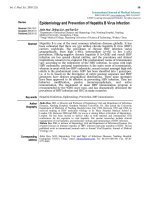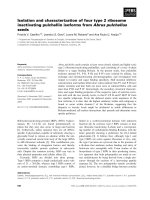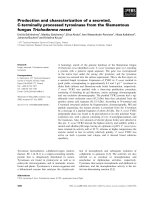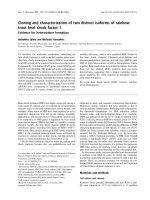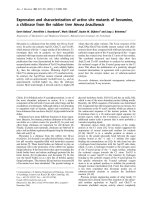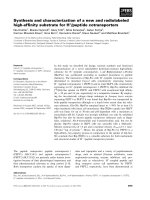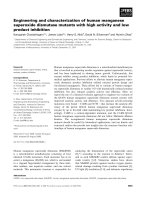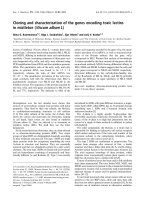Báo cáo y học: " Sequencing and characterization of Varicella Zoster virus vaccine strain SuduVax" pptx
Bạn đang xem bản rút gọn của tài liệu. Xem và tải ngay bản đầy đủ của tài liệu tại đây (1.52 MB, 19 trang )
This Provisional PDF corresponds to the article as it appeared upon acceptance. Fully formatted
PDF and full text (HTML) versions will be made available soon.
Sequencing and characterization of Varicella Zoster virus vaccine strain
SuduVax
Virology Journal 2011, 8:547 doi:10.1186/1743-422X-8-547
Jong IK Kim ()
Gyoo S Jung ()
Yu Y Kim ()
Ga Y Ji ()
Hyung S Kim ()
Wen D Wang ()
Ho S Park ()
Song Y Park ()
Geun H Kim ()
Shi N Kwon ()
Keon M Lee ()
Jin H Ahn ()
Yeup Yoon ()
Chan H Lee ()
ISSN 1743-422X
Article type Research
Submission date 29 July 2011
Acceptance date 16 December 2011
Publication date 16 December 2011
Article URL />This peer-reviewed article was published immediately upon acceptance. It can be downloaded,
printed and distributed freely for any purposes (see copyright notice below).
Articles in Virology Journal are listed in PubMed and archived at PubMed Central.
For information about publishing your research in Virology Journal or any BioMed Central journal, go
to
Virology Journal
© 2011 Kim et al. ; licensee BioMed Central Ltd.
This is an open access article distributed under the terms of the Creative Commons Attribution License ( />which permits unrestricted use, distribution, and reproduction in any medium, provided the original work is properly cited.
/>For information about other BioMed Central publications go to
/>Virology Journal
© 2011 Kim et al. ; licensee BioMed Central Ltd.
This is an open access article distributed under the terms of the Creative Commons Attribution License ( />which permits unrestricted use, distribution, and reproduction in any medium, provided the original work is properly cited.
Sequencing and characterization of Varicella
Zoster virus vaccine strain SuduVax
ArticleCategory :
Research
ArticleHistory :
Received: 29-Jul-2011; Accepted: 02-Dec-2011
ArticleCopyright
:
© 2011 Kim et al; licensee BioMed Central Ltd. This is an Open Access
article distributed under the terms of the Creative Commons Attribution
License, which permits unrestricted use, distribution, and reproduction in
any medium, provided the original work is properly cited.
Jong Ik Kim,
Aff1
Email:
Gyoo Seung Jung,
Aff1
Email:
Yu Young Kim,
Aff1
Email:
Ga Young Ji,
Aff1
Email:
Hyung Seok Kim,
Aff1
Email:
Wen Dan Wang,
Aff1
Email:
Ho Sun Park,
Aff2
Email:
Song Yong Park,
Aff3 Aff4
Email:
Geun Hee Kim,
Aff3
Email:
Shi Nae Kwon,
Aff3
Email:
Keon Myung Lee,
Aff6
Email:
Jin Hyun Ahn,
Aff5
Email:
Yeup Yoon,
Aff3
Email:
Chan Hee Lee,
Aff1 Aff7
Corresponding Affiliation:
Aff1
Phone: +82-43-2612304
Fax: +82-43-2732451
Email:
Aff1
Department of Microbiology, Chungbuk National University, Cheongju,
South Korea
Aff2
Department of Micorbiology, College of Medicine, Yeungnam
University, Daegu, South Korea
Aff3
Mogam Biotechnology Research Institute, Yongin, South Korea
Aff4
Green Cross Company, Yongin, South Korea
Aff5
Department of Molecular Cell Biology, Sungkyunkwan University
School of Medicine, Suwon, South Korea
Aff6
Department of Computer Science, Chungbuk National University,
Cheongju, South Korea
Abstract
Background
Varicella zoster virus (VZV) causes chickenpox in children and shingles in older people.
Currently, live attenuated vaccines based on the Oka strain are available worldwide. In Korea, an
attenuated VZV vaccine has been developed from a Korean isolate and has been commercially
available since 1994. Despite this long history of use, the mechanism for the attenuation of the
vaccine strain is still elusive. We attempted to understand the molecular basis of attenuation
mechanism by full genome sequencing and comparative genomic analyses of the Korean vaccine
strain SuduVax.
Results
SuduVax was found to contain a genome that was 124,759bp and possessed 74 open reading
frames (ORFs). SuduVax was genetically most close to Oka strains and these Korean-Japanese
strains formed a strong clade in phylogenetic trees. SuduVax, similar to the Oka vaccine strains,
underwent T- > C substitution at the stop codon of ORF0, resulting in a read-through mutation to
code for an extended form of ORF0 protein. SuduVax also shared certain deletion and insertion
mutations in ORFs 17, 29, 56 and 60 with Oka vaccine strains and some clinical strains.
Conclusions
The Korean VZV vaccine strain SuduVax is genetically similar to the Oka vaccine strains.
Further comparative genomic and bioinformatics analyses will help to elucidate the molecular
basis of the attenuation of the VZV vaccine strains.
Keywords
Varicella-zoster virus, SuduVax, Genome, Phylogeny
Background
Varicella zoster virus (VZV) is an alpha-herpesvirus and the cause of chickenpox (varicella) and
shingles (zoster). Chickenpox is characterized by fever and generalized rash, and is most
prevalent in children due to primary infection. VZV can establish a latent infection in nerve cells
of dorsal root ganglia and its reactivation from latency causes shingles in older adults and in
immunocompromised people.
Isolation and propagation of VZV in cell culture was first reported in 1953 [1], and the first
determination of the complete nucleotide sequence was made from the Dumas strain [2]. As of
August 2010, complete nucleotide sequences had been determined and were available from
NCBI GenBank database from 23 VZV strains including three vaccine strains derived from the
Oka strain. Comparison of the full nucleotide sequences of clinical with vaccine strains has
enabled researchers to suggest putative regions that might be responsible for attenuation in
vaccine strains [3-6].
In Korea, the pharmaceutical company GCC has been manufacturing an attenuated VZV vaccine
for chickenpox since 1994. The live-attenuated vaccine strain, SuduVax®, was obtained through
serial passage of wild-type virus in cell culture. The original wild-type virus was isolated in
primary human embryonic lung (HEL) cell culture from a 33-month-old boy with chickenpox in
1989 in Seoul, Korea [7]. The virus was attenuated by 10 passages in HEL cells, 12 passages in
guinea pig embryonic lung cells, and passaged five times in HEL cells to prepare an attenuated
strain, designated MAV06, for vaccine production [8]. The attenuated viruses were stored in
liquid nitrogen (master virus banks). Working virus banks are routinely produced after five
passages of master virus bank stocks in HEL cells. The final vaccine (SuduVax) is manufactured
after passaging of the working virus bank five times in HEL cells.
SuduVax has been marketed in Korea since 1994 and internationally since 1998. Although the
efficacy and safety of SuduVax have been proved in the marketplace, molecular studies
explaining the mechanism of attenuation or the efficacy of the vaccine have not been available.
In this study, the complete nucleotide sequence of SuduVax was determined and compared with
those of 23 VZV strains whose full genomic sequences are registered in the NCBI GenBank
database.
Results
Overall genome structure of the Korean vaccine strain SuduVax
The genome of the VZV strain SuduVax was determined to be 124,759bp. The architecture of
the SuduVax genome is typical of VZV in that the genome could be divided into TRL, UL, IRL,
IRS, US and TRS (88, 104,799, 88, 7,276, 5,232, and 7276bp, respectively). The G + C content of
the SuduVax genome is approximately 46.1%. The lengths of the genome, lengths of each region
and the G + C contents are very similar among the 24 VZV strains analyzed in this study (Table
1). The SuduVax genome contains 74 ORFs. Of these 64 are UL genes and four are US genes.
Three genes in IRS (ORFs 62–64) are inversely repeated in TRS (ORFs 69–71). Of the 74 ORFs,
39 are in the forward direction and 35 are in the reverse direction. The directions of ORFs are
100% conserved among the analyzed VZV strains. The ORF map of strain SuduVax is presented
in Figure 1.
Table 1 Information of the VZV strains analyzed in this study
Length (bp)
Strain
Accession
Number
Country
Genome TRL UL IRL IRS US TRS
%G+C
Dumas NC001348 Netherlands 124,884 88 104,836 88 7,320 5,232 7,320 46.0
M2DR DQ452050 Morocco 124,770 89 104,719 89 7,320 5,232 7,321 46.0
CA123 DQ457052 USA 124,771 100 104,698 98 7,322 5,232 7,321 46.0
SD DQ479953 USA 125,087 88 104,787 88 7,446 5,232 7,446 46.1
Kel DQ479954 USA 125,374 88 104,857 88 7,555 5,232 7,554 46.2
11 DQ479955 Canada 125,370 88 104,906 88 7,529 5,232 7,527 46.2
22 DQ479956 Canada 124,868 88 104,689 88 7,386 5,232 7,385 46.0
03-500 DQ479957 Canada 125,239 88 105,299 88 7,266 5,232 7,266 46.1
36 DQ479958 Canada 125,030 88 104,850 88 7,387 5,232 7,385 46.1
49 DQ479959 Canada 125,041 88 104,916 88 7,358 5,232 7,359 46.1
8 DQ479960 Canada 125,451 89 105,020 88 7,510 5,232 7,512 46.2
32p5 DQ479961 USA 124,945 88 104,760 88 7,389 5,232 7,388 46.1
32p22 DQ479962 USA 125,084 88 104,791 88 7,443 5,232 7,442 46.1
32p72 DQ479963 USA 125,169 88 104,870 88 7,446 5,232 7,445 46.1
NH29_3 DQ674250 USA 124,811 87 104,766 87 7,320 5,230 7,321 46.0
SVETA EU154348 Russia 124,813 87 104,772 87 7,319 5,230 7,318 46.0
MSP AY548170 USA 124,883 88 104,848 88 7,313 5,232 7,314 46.0
BC AY548171 Canada 125,459 88 105,326 88 7,363 5,231 7,363 46.2
HJ0 AJ871403 Germany 124,928 89 104,752 89 7,335 5,230 7,433 46.0
pOka AB097933 Japan 125,125 88 104,798 88 7,463 5,225 7,463 46.1
vOka AB097932 Japan 125,078 88 104,822 88 7,427 5,232 7,421 46.1
VarilRix DQ008354 Japan 124,821 88 104,761 88 7,326 5,231 7,327 46.1
VariVax DQ008355 Japan 124,815 88 104,758 88 7,324 5,232 7,325 46.1
SuduVax This study Korea 124,759 88 104,799 88 7,276 5,232 7,276 46.1
Figure 1 ORF map of the VZV strain SuduVax. The direction of the arrows indicates the
direction of transcription
Phylogenetic analysis
Phylogenetic trees were constructed using the full nucleotide sequences of SuduVax and 23 VZV
strains whose full genomic DNA sequences are known. As shown in an unrooted tree generated
by maximum-likelihood method, SuduVax and four Oka strains (pOka, vOka, VarilRix,
VariVax) formed a clade and strains M2DR and 8 formed an adjacent clade (Figure 2a). These
two clades were joined with the clade whose member was the strain CA123 only. Strains 11, 22,
03–500 and HJ0 formed another clade and the rest of the clinical strains formed the last clade.
Almost identical topology was observed in a tree generated by neighbour-joining method (data
not shown) and Bayesian method [9]. SuduVax together with Oka strains formed a distinctive
clade, corresponding to clade 2 proposed by the VZV Nomenclature Meeting 2008 [10]. When
trees were constructed with concatenated coding nucleotide sequences (ORF) or amino acid
sequences, similar tree topologies were obtained (data not shown). Next, we tried to build
phylogenetic trees using non-coding sequences. Again, SuduVax grouped with four Oka strains,
forming clade 2 (Figure 2b). One notable difference between the trees built by full or coding
sequences and the tree built by non-coding sequences was the location of pOka, the parental Oka
strain from which vaccine strain vOka was derived. While pOka was located between the four
vaccine strains and 19 clinical strains in the tree built by full or coding sequences, pOka was
buried among the vaccine strains in tree built by non-coding sequences (compare Figures 2a, b).
In other words, four vaccine strains (vOka, VarilRix, VariVax, and SuduVax) formed a subclade
within the clade 2 in the trees built by full or coding sequences (bootstrap value = 1,000 in
neighbour-joining trees), but not in the tree built by non-coding sequences.
Figure 2 Phylogenetic analysis of 24 VZV strains. Nucleotide or amino acid sequences were
multiple-aligned using ClustalW program (ver 2.0.1) and the resulting *.phy files were used to
construct phylogenetic trees using maximum-likelihood (ML) or neighbor-joining (NJ) methods
in Phylip package (version 3.69). (a) ML tree based on full nucleotide sequences. (b) ML tree
based on non-coding sequences. (c) NJ tree based on the nucleotide sequences of ORF62,
showing clear separation of vaccine strains from pOka within clade 2. (d) NJ tree based on the
nucleotide sequences of ORF1. Vaccine strains are separated from clinical strains, but formation
of clade 2 is not evident
In order to find which ORFs are important in distinguishing vaccine strains from clinical strains,
further phylogentic analyses using individual ORF were performed. Of the 74 phylogenetic trees,
12 ORF trees exhibited clear braches leading to a formation of clusters consisting of vaccine
strains. These 12 ORFs included ORF 0, 1, 6, 18, 31, 35, 39, 59, 62, 64, 69 and 71 (Figure 2c).
The bootstrap values for vaccine clusters were greater than 640. In majority of ORF trees,
vaccine clusters formed subclades within clade 2. However, in phylogenetic trees based on ORFs
1, 18, 39 and 59, branches leading to clade 2 were not present or very short with low bootstrap
values (Figure 2d). Thus, the vaccine strains did not always form a subclade within clade 2.
Evolutionary relationships between the Korean vaccine strain SuduVax and other VZV strains
were investigated by calculating genetic distances among the 24 VZV strains. As a whole, VZV
genome sequences were highly conserved among the strains. At the level of full nucleotide
sequences, SuduVax was the most similar to VarilRix, followed by vOka, VariVax and pOka
(Table 2). Similar results were obtained when the genetic distances were calculated using
concatenated non-coding nucleotide sequences or amino acid sequences. The average distance
between SuduVax and three vaccine strains at the full nucleotide level was calculated to be 0.20
± 0.05 × 10
-3
, which was <10% of the average distance between SuduVax and 20 clinical strains
(2.08 ± 0.39 × 10
-3
, Table 2). Among the clinical strains except for pOka, strain 8 was the most
similar to SuduVax.
Table 2 Genetic distances between SuduVax and other VZV strains
Nucleotide (×10
-3
) Amino acid
Strains
Full Noncoding
(×10
-3
)
Dumas 2.31 3.79 3.09
M2DR 1.87 2.77 2.57
CA123 2.34 3.50 2.75
SD 2.24 2.84 3.04
Kel 2.26 2.70 3.27
11 2.10 3.87 3.09
22 2.12 4.08 2.96
03–500 2.30 3.80 2.80
36 2.18 2.63 3.06
49 2.18 2.70 4.49
8 1.83 2.19 2.35
32p5 2.14 2.77 3.09
32p22 2.19 2.77 4.27
32p72 2.26 2.70 5.03
NH29_3 2.11 3.13 2.85
SVETA 2.15 3.43 3.01
MSP 2.21 3.35 2.93
BC 2.11 2.62 3.09
HJ0 2.20 4.00 2.98
pOka 0.53 0.58 0.97
vOka 0.19 0.15 0.57
VarilRix 0.16 0.07 0.47
VariVax 0.25 0.44 0.63
Average
Vaccine
0.20 0.22 0.56
Clinical
2.08 3.01 3.08
Mutations found in SuduVax ORFs
SuduVax ORF0 exists as longer form due to a read-through mutation. The stop codon TGA
(nucleotide position 388–390) was mutated to CGA coding for Arg. A putative stop codon TGA
was found downstream and overlapped with ORF1 (Figure 3). This extended ORF0 encoded a
new protein with 221 amino acid residues. The same read-through mutation was found in other
vaccine strains, vOka, VarilRix and VariVax. All clinical strains including pOka contained
390bp-long ORF0 coding for 129 amino acids.
Figure 3 Read-through mutation in ORF0 of SuduVax and Oka vaccine strains. ORF0 sequences
of 24 VZV strains were extracted and aligned using the ClustalW program. Substitution of
T388C and putative downstream new stop codon TGA are shaded
Compared to the reference strain Dumas, the lengths of ORF17 and ORF56 of the strain
SuduVax were 3bp short due to deletion of TCA at position 367 to 369 and TCT at position 658
to 660, respectively. Both deletions resulted in deletion of amino acid S residue. On the other
hand, insertion of three nucleotides ATG at position 27 was found in ORF60 of the strain
SuduVax. Interestingly, the aforementioned two deletions and one insertion were also found in
all Oka strains including pOka. SuduVax as well as Oka strains were found to have a15 bp
(AACATTTCAGGGTCA) shorter ORF29 than most clinical isolates that contain two tandem
reiterations of this 15 bp sequence. Among the clinical strains, M2DR, CA123 and 8 contained
only one copy of the 15 bp element in ORF29. Strains M2DR and 8 shareed the same length for
ORF60 with Oka and SuduVax strains. Table 3 summarizes the insertion and deletion mutations
found in SuduVax.
Table 3 Deletions and insertion found in SuduVax
Mutation Nucleotide
Amino
acid
ORF Also found in
Deletion TCA S ORF17 4Oka
1
AACATTTCAGGGTCA NISGS ORF29 4Oka, M2DR, CA123, 8
TCT S ORF56 4Oka
Insertion ATG M ORF60 4Oka, M2DR, 8
1
pOka, vOka, VariVax, and VarilRix
Discussion
VZV strain SuduVax has been used by a Korean pharmaceutical company to produce live
attenuated vaccine for chickenpox since 1994. Although its efficacy and safety have been proven
in the marketplace, molecular characteristics of the vaccine strain have not been available. In this
study sequencing and analyses of the nucleotide sequence of the Korean varicella vaccine strain
SuduVax were undertaken.
In the original paper on the first complete sequencing of VZV strain Dumas [2], 71 ORFs were
proposed. However, the information obtained from the NCBI GenBank database for Dumas
(NC_001348) identifies 73 ORF if three ORFs located in TRS are counted as separate ORFs.
Sequencing of two Oka-derived vaccine strains, VarilRix (DQ008354) and VariVax
(DQ008355), identified 72 ORFs [5]. A Blast search using these three strains as queries
produced 74 possible ORFs for VZV. We were presently able to locate ORF45 (position 81,523–
82,593) to Dumas and ORF33.5 to VarilRix (position 60,257 – 61,165) and VariVax (60,254 –
61,162). Extended from of ORF0 due to read-through mutation was identified in SuduVax as
well as in Oka vaccine strains (see below). Using these reference strains Dumas and VarilRix as
queries, we were able to identify and locate 74 ORFs in the genome of the strain SuduVax as
well as in other 23 VZV strains analyzed in this study.
Phylogenetic analysis using the full nucleotide sequences of 24 VZV strains identified five
distinct clades, consistent with previous findings [9,10]. Phylogenetic trees constructed with
concatenated amino acid sequences and coding nucleotide sequences also revealed five clades
with the same members. The tree built using non-coding nucleotide sequences appeared similar
to the other trees, except that the strains 8 and M2DR did not form a clear clade as in other trees.
SuduVax co-clustered with Oka strains and this clade consisted exclusively of isolates from
Japan and Korea in clade 2. SuduVax shares the minimum complement of single nucleotide
polymorphism at 27 positions [10] with other members of the clade 2. Various genotyping
methods using limited genetic information of VZV strains have been proved to represent
genotyping using full genome information [11-15]. Any genotyping method unequivocally
placed SuduVax to the same genogroup with Oka strains as in phylogenetic trees based on full or
near-full genetic information (data not shown).
It is not presently certain, because of the lack of full genome sequences from other Asian
isolates, whether this clade 2 cloud can be extended to include isolates from other Asian
countries or whether it is confined to isolates from Japan and Korea only. However, available
data based on partial nucleotide sequences or restriction fragment length polymorphism suggest
that all Korean isolates and Chinese isolates form a clade with Japanese isolates [16,17]. Thus, it
is possible that the clade 2 could be extended to include China, which is geographically close to
Japan and Korea.
Coding sequences occupy approximately 91% of the VZV genome and reflect most of the
sequence information of the whole genome. Thus, it was expected that the phylogenetic trees
based on the coding sequences are very similar to the trees based on the full nucleotide
sequences. We found that the coding sequence trees and amino acid trees were similar to the full
nucleotide trees. Noncoding sequences were found to be interspersed between coding sequences
or ORFs, accounting for approximately 9% of the VZV genome. The phylogenetic trees based on
VZV noncoding sequences are not different from those based on full or coding nucleotide
sequences or amino acid sequences. One notable difference is the location of pOka within clade
2. In full or coding sequence trees, pOka was separated from four vaccine strains to form two
independent subclades within clade 2. On the contrary, pOka did not form a subclade separated
from vaccine strains in nonconding sequence trees. pOka is a clinical strain. Thus, coding
sequences or amino acid sequences of VZV genome may provide information distinguishing
vaccine strains from clinical strains, while noncoding sequences does not.
Phylogenetic analyses using the nucleotide sequences of individual ORFs suggested 12 ORFs
may be important in distinguishing vaccine strains from clinical strains. Yamanish identified 23
ORFs that are different between pOka and Oka vaccine [6], including 12 ORFs identified in this
study. Moreover, our preliminary studies of single nucleotide polymorphism among the full
genomic DNA sequences of the 24 VZV strains revealed 12 ORFs that may be characteristic for
vaccine strains and these 12 ORFs coincide with the above-mentioned 12 ORFs [manuscript in
preparation].
ORF0, also known as ORFS/L, is thought to be essential for VZV growth and encodes a
membrane protein with 129 amino acid residues, which is possibly involved in vesicular
trafficking and altering cell adhesion molecules in infected cells [18,19]. ORF0 in SuduVax was
determined to possess an extended C-terminal sequence due to a read-through mutation of its
original stop codon TGA to CGA coding for Arg. The nearest downstream stop codon TGA was
found to overlap with ORF1 and the extended ORF0 is expected to code for a new protein with
221 amino acid residues. Interestingly, this read-through mutation was also found in the three
Oka-derived vaccine strains, while the stop codons were found to be unaltered in all of the
clinical strains including the parent Oka strain. In cells infected with vOka, the extended form of
ORF0 protein with 221 amino acid residues and its spliced form with 155 amino acid residues
are expressed [20]. Since other vaccine strains, including SuduVax, share 100% identical
nucleotide sequences within and downstream of ORF0 up to the new stop codon, both forms of
the extended ORF0 proteins are expected to be expressed in permissive cells infected with
SuduVax. Thus, read-through mutation in ORF0 might be an important feature distinguishing
vaccine strains from clinical strains.
Besides the read-through mutation in ORF0, SuduVax share same mutational events in ORFs 17,
29, 56 and 60 with Oka strains. ORF17 codes for an mRNA-specific RNase [21] and ORF29
encodes single strand DNA binding protein via its zinc-finger domain [22]. The function of
ORF56 has not been well characterized, but its gene product is reported to co-localize with
regulatory protein ICP22 and nuclear protein UL3 in small, dense nuclear bodies (NCBI,
( />487683). The gene product of ORF60 is glycoprotein L, which acts as a chaperon for
glycoprotein H [23]. Three bp deletions were found in ORFs 17 and 56, and an insertion of 3-bp
was found in ORF60. While most of the clinical strains contain two tandem copies of 15bp
(AACATTTCAGGGTCA) elements in ORF29, while the SuduVax and Oka strains contain only
one copy of this 15bp element. Of these four deletion and insertion events, two events (ORFs 29,
60) are shared with the clinical strains 8 and M2DR, and one event (ORF29) is also found in the
strain CA123. Since these deletion and insertion events are also found in some of the clinical
strains including pOka, they by themselves may not be important in attenuation, although it is
still possible that they, in combination with other events such as read-through mutation in ORF0,
may play some roles in attenuation of vaccine strains.
Conclusion
We obtained and analyzed full nucleotide sequence of the Korean vaccine strain SuduVax.
SuduVax was shown to be genetically most similar to Oka-derived vaccine strains. We are now
comparing the SuduVax nucleotide and amino acid sequences with those of other vaccine and
clinical strains. Further comparative genomic and bioinformatics analyses will help to elucidate
the molecular basis of the attenuation of the VZV vaccine strains.
Materials and methods
Virus and DNA sequencing
DNA of the VZV strain SuduVax was extracted from commercial vials of SuduVax
TM
with
QIAamp DNA Mini Kit (QIAGEN) at a concentration of 5.5 g/100 L. The DNA sequence was
determined by the high throughput sequencing method using a Genome Sequencer FLX
Titanium System of Roche Diagnostics, serviced by Macrogen. Sequence fragments (n = 23,722)
with an average length of approximately 400bp were obtained and these were assembled and
viewed using the Consed program (
The average quality of the sequence fragments was more than 99.99%. A total of 99.38% of the
124,759 sequences aligned with the derived consensus sequence and the average coverage was
83 reads per nucleotide. These were aligned against reference strain Dumas (NC_001348) and
vaccine strain VarilRix (DQ008354). The gaps between the contigs were filled by polymerase
chain reaction sequencing using primers whose sequences were obtained from the adjacent
contigs. The completed sequence was deposited into NCBI GenBank (accession number
JF306641).
Allocation of ORFs
ORFs of the strain SuduVax in the full genome sequence was located by Blast search against two
reference strains Dumas (NC_001348) and VarilRix (DQ008354). Complementary determining
sequences (CDSs) of the reference strains were extracted using FeatureExtract 1.2 Server
program ( and used as query. The resulting data
included the first and last nucleotide positions of the each ORF in the strain SuduVax genome
and direction of the ORFs. The ORF information was verified by ORF finding programs such as
CLC Sequence Viewer (version 6.4, and ORF Finder
provided by NCBI. When the results of Blast search did not coincide with those of ORF finding
programs, the nucleotide sequences of the corresponding ORFs were examined with BioEdit
Sequence Alignment Editor (Department of Microbiology, North Carolina State University,
version 7.0.5.3, and manually edited to locate
the position of the start and stop codons. Finally all the allocated ORFs were confirmed by
identification of the translated amino acid sequences.
Phylogenetic analysis
Nucleotide sequences of the VZV full genome other than SuduVax were obtained directly from
GenBank database (Table 1). For each VZV strain, all ORF sequences were cut and pasted to
generate a concatenated coding sequence. Similarly, all inter-ORF sequences were cut and pasted
to build a concatenated noncoding sequence. Amino acid sequences were obtained by translation
of the corresponding ORFs and pasted to generate a concatenated sequence harbouring all 74
ORFs. These full or concatenated nucleotide or concatenated amino acid sequence of the 24
VZV strains were multiple-aligned using the ClustalW program (ver 2.0.1) followed by manual
editing. The resulting out-files were used to calculate genetic distances using Dnadist (for
nucleotide) or Prodist (for amino acid) program included in Phylip package (version 3.69,
Distance matrix was obtained by Kimura-
2-paramenter for nucleotide or Jones-Taylor-Thornton method for amino acid. Cluster analysis
was performed by neighbour-joining (NJ) and maximum-likelihood (ML) method and resulting
tree files were viewed by Treeview program (version 1.6.6). The significance of the phylogenetic
trees was verified by bootstrap analysis. Phylogenetic trees were constructed from 1,000
replicates generated by the Seqboot program and the consensus tree was identified by the
Consense program.
Abbreviations
HEL, Human embryonic lung; ML, Maximum likelihood; NJ, Neighbour-joining; ORF, Open
reading frame; VZV, Varicella-zoster virus
Competing interests
The authors declare that they have no competing interests.
Authors’ contributions
HSP, SYP, KML and CHL conceived and designed the experiments. JIK, GSJ, YYK, GYJ,
HSK, WDW and CHL performed experiments and analyzed the data. SYP, GHK, and SNK
prepared samples. JIK, GSJ and CHL wrote the paper. All authors read and approved the final
manuscript.
Acknowledgement
This work was supported by the Korea Research Foundation Grant funded by the Korean
Government (Ministry of Education, Science and Technology, The Regional Research
Universities Program/Chungbuk BIT Research-Oriented University Consortium).
References
1. Weller TH: Serial propagation in vitro of agents producing inclusion bodies derived
from varicella and herpes zoster. Proc Soc Exp Biol Med 1953, 83(2):340–346.
2. Davison AJ, Scott JE: The complete DNA sequence of varicella–zoster virus. J Gen Virol
1986, 67(Pt 9):1759–1816.
3. Argaw T, Cohen JI, Klutch M, Lekstrom K, Yoshikawa T, Asano Y, Krause PR: Nucleotide
sequences that distinguish Oka vaccine from parental Oka and other varicella–zoster
virus isolates. J Infect Dis 2000, 181(3):1153–1157.
4. Gomi Y, Sunamachi H, Mori Y, Nagaike K, Takahashi M, Yamanishi K: Comparison of
the complete DNA sequences of the Oka varicella vaccine and its parental virus. J Virol
2002, 76(22):11447–1159.
5. Tillieux SL, Halsey WS, Thomas ES, Voycik JJ, Sathe GM, Vassilev V: Complete DNA
sequences of two oka strain varicella-zoster virus genomes. J Virol 2008, 82(22):11023–
11044.
6. Yamanishi K: Molecular analysis of the Oka vaccine strain of varicella-zoster virus. J
Infect Dis 2008, 197(Suppl 2):S45–48.
7. Hwang KK, Park SY, Kim SJ, Ryu YW, Kim KH: Restriction fragment length
polymorphism analysis of Varicella-Zoster Virus isolated in Korea. J Kor Soc Virol
1991, 21(2):201–210.
8. Sohn YM, Park CY, Hwang KK, Woo GJ, Park SY: Safety and immunogenicity of live
attenuated Varicella Virus Vaccine (MAV/06). J Kor Pediatr Soc 1994, 37:1405–1413.
9. Loparev V, Martro E, Rubtcova E, Rodrigo C, Piette JC, Caumes E, Vernant JP, Schmid DS,
Fillet AM: Toward universal varicella-zoster virus VZV genotyping: diversity of VZV
strains from France and Spain. J Clin Microbiol 2007, 45(2):559–563.
10. Breuer J, Grose C, Norberg P, Tipples G, Schmid DS: A proposal for a common
nomenclature for viral clades that form the species varicella-zoster virus: summary of
VZV Nomenclature Meeting 2008, Barts and the London School of Medicine and
Dentistry, 24–25 July 2008. J Gen Virol 2010, 91(Pt 4):821–828.
11. Barrett-Muir W, Scott FT, Aaby P, John J, Matondo P, Chaudhry QL, Siqueira M, Poulsen
A, Yaminishi K, Breuer J: Genetic variation of varicella-zoster virus: evidence for
geographical separation of strains. J Med Virol 2003, 70(Suppl 1):S42–S47.
12. Faga B, Maury W, Bruckner DA, Grose C: Identification and mapping of single
nucleotide polymorphisms in the varicella-zoster virus genome. Virology 2001, 280(1):
1–6.
13. Loparev VN, Gonzalez A, Deleon-Carnes M, Tipples G, Fickenscher H, Torfason EG,
Schmid DS: Global identification of three major genotypes of varicella-zoster virus:
longitudinal clustering and strategies for genotyping J Virol 2004, 78(15):8349–8358.
14. Peters GA, Tyler SD, Grose C, Severini A, Gray MJ, Upton C, Tipples GA: A full-genome
phylogenetic analysis of varicella-zoster virus reveals a novel origin of replication-based
genotyping scheme and evidence of recombination between major circulating clades. J
Virol 2006, 80(19):9850–9860.
15. Wagenaar T R, Chow VT, Buranathai C, Thawatsupha P, Grose C: The out of Africa model
of varicella-zoster virus evolution: single nucleotide polymorphisms and private alleles
distinguish Asian clades from European/North American clades. Vaccine 2003, 21(11–
12): 1072–1081.
16. Liu J, Wang M, Gan L, Yang S, Chen J. Genotyping of clinical varicella-zoster virus
isolates collected in China. J Clin Microbiol 2009, 47(5):1418–1423.
17. Kim KH, Choi YJ, Song KH, Park WB, Jeon JH, Park SW, Kim HB, Kim NJ, Oh MD:
Genotype of varicella-zoster virus isolates in South Korea. J Clin Microbiol 2011,
49(5):1913–1916.
18. Kemble GW, Annunziato P, Lungu O, Winter RE, Cha TA, Silverstein SJ, Spaete RR: Open
reading frame S/L of varicella-zoster virus encodes a cytoplasmic protein expressed in
infected cells. J Virol 2000, 74(23):11311–11321.
19. Zhang Z, Rowe J, Wang W, Sommer M, Arvin A, Moffat J, Zhu H: Genetic analysis of
varicella-zoster virus ORF0 to ORF4 by use of a novel luciferase bacterial artificial
chromosome system. J Virol 2007, 81(17):9024–9033.
20. Koshizuka T, Ota M, Yamanishi K, Mori Y: Characterization of varicella-zoster virus-
encoded ORF0 gene-comparison of parental and vaccine strains. Virology 2010,
405(2):280–288.
21. Sato H, Callanan LD, Pesnicak L, Krogmann T, Cohen JI: Varicella-zoster virus VZV
ORF17 protein induces RNA cleavage and is critical for replication of VZV at 37
degrees C but not 33 degrees C. J Virol 2002, 76(21):11012–11023.
22. Stallings CL, Duigou GJ, Gershon AA, Gershon MD, Silverstein SJ: The cellular
localization pattern of Varicella-Zoster virus ORF29p is influenced by proteasome-
mediated degradation. J Virol 2006, 80(3):1497–1512.
23. Duus KM, Hatfield C, Grose C: Cell surface expression and fusion by the varicella-zoster
virus gH:gL glycoprotein complex: analysis by laser scanning confocal microscopy.
Virology 1995, 210(2):429–440.
Figure 1
Figure 2
Figure 3
